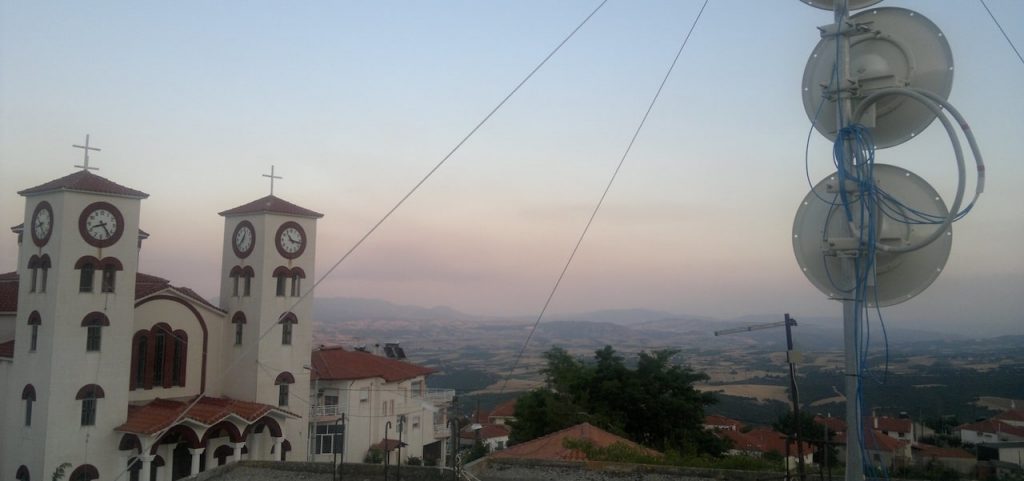
At the beginning of May 2020, the Sarantaporo.gr community network team was approached by the Mayor of Elassona, a municipality in the Thessaly region in central Greece. He was asking for help with a very common problem that villages in our municipality face: lack of access to Internet connectivity.
“Sykea” or “Sykia” is an isolated village in Elassona with almost 600 inhabitants who had no Internet connectivity. 3G and 4G mobile coverage is barely available in the area, tainting the village with multiple “white spots.” The digital silence there was painfully loud during the two-month COVID-19 lockdown, from April to May 2020, leaving the locals even further behind in a period of grave need for access to information and digital services. But this connectivity gap has not always been like this.
Telecommunications as a Cultural Legacy
In the past, before the advent of the Internet, villagers enjoyed the connectivity that was available, which at the time was simply a landline. Whether you lived in a city or in a village, you didn’t have any other option. For many decades the telecom incumbent, OTE, which was a public company at the time, provided telephone service universally throughout the country. A lot of the telecommunications infrastructure being used today by the incumbent was built by locals, who volunteered to “bring the telephone to the village.”
Back then it was not unusual for local communities to raise the funds needed to buy the poles and cables, which they assembled themselves under the instructions of technicians sent by the state telecommunications company. Thus, the ex-national telecom infrastructure was not just poles, cables, and active equipment. It also incorporated a precious cultural value. This cultural heritage is strikingly similar to what communities are doing today with community networks in the region, and in other parts of the country and the world.
All that infrastructure eventually became the property of the now privatized incumbent.
Leaving the Villages Behind
Over the years, as it happens with all network construction, the equipment aged and required maintenance. It coincided with the population becoming even more sparse as young people moved to urban centers in search of opportunities for a better life. With the population decline, the math for return on investment no longer added up. Keeping the service running became a liability for the company.
This is how the village of Sykea found itself lacking Internet connectivity when the pandemic broke out. The locals made a lot of noise around the issue via mass media, the local administration, the ministry, and formal inquiries to the Greek parliament, but to no avail. Eventually, Elassona’s mayor contacted Sarantaporo.gr to ask for help. We decided to expand our infrastructure in the area, and the agreement gained visibility in the local and national media.
For almost one and a half months, while waiting for the pandemic lockdown measures to be withdrawn, we worked on getting the local community members together, collecting the data we needed to design the infrastructure and preparing the necessary workshops and presentations for the participating community members. We were ready to expand our community network.
A Small Victory
The publicity of this collaboration worked well for the village – in an unexpected way. A local representative of the incumbent contacted the mayor to inform him that they were doing what was necessary to provide broadband services to the area. This was a setback for our community network plan, as the community members we were working with were not given the necessary time (or proximity, due to the COVID-19 distancing) to engage in the community networking spirit. Their drive was Internet connectivity and access. Once the incumbent provided a straightforward solution to the community, they stepped back from collaborating with us on building their own community network.
We are aware that surfacing the value of a community-owned telecommunications infrastructure is an issue in its own right. For us this became apparent from the first time we sat down and planned with our local community members for expansion of our infrastructure to unserved locations in their area. For these people, the power to decide where and when to expand connectivity is driven by the community’s needs.
The experience with Sykea has been insightful and educational in verifying the conclusions we have reached after working for many years in the area. Building a community network relies heavily on cultural aspects of the local community. Given two solutions, most people will almost always go with the simplest. It takes an active participant’s mentality instead of a consumer approach to build a community network. And this is a transformation that takes time and energy to achieve in a market-dominated culture.
Though the plan to expand our community network to Sykea village was not fulfilled, we are happy that they managed to get access to the Internet. This is an example of the positive impact of a collective effort achieved via local community organizing. The experience will remain with the local community and hopefully grow to crystalize as collective wisdom.
Sykea has been able to achieve its goal of Internet connectivity – and this has opened up an opportunity to tend to the needs of other communities.
Stay tuned as we share more of the Sarantaporo journey to connect communities in Northern Greece.
Image of Sarantaporo Community Network in Elassona, Greece
People around the world are building community networks to bridge their digital divide. Find out how you can be a part of it!
—
Source of this article: internetsociety.org


